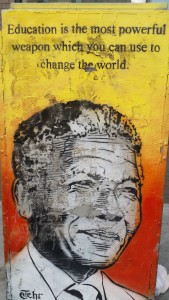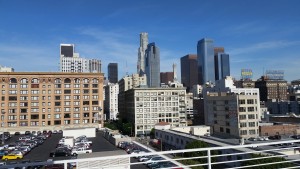In the whirlwind of returning from LA, writing our magazine articles, and preparing for our presentation with the Mindanao group (not to mention catching up on other coursework), I felt like there wasn’t enough time to truly decompress and reflect on the experience. In fact, over a month after the fact, it is something I am still processing…
Like most things, I would have preferred to have more time to work with the two groups – LA and Mindanao – to create a more cohesive and rehearsed presentation. Time constraints necessitate urgency sometimes and all things considered, I think we pulled it off smashingly. If there is anything I have learned from my years as a performer it is that somehow – despite an incomplete dress rehearsal or maybe because of it – when the audience arrives and the lights come up, people rally and the show comes together. Somehow. I would say that our combined trip presentation: Violence Explained and Peace Explored was a MIIS event success. I received only positive feedback from the attendees and not only the obligatory congratulations kind. I had audience members, including faculty, tell me they were glad they came because it reminded them to re-visit these conflict laden issues that are often swept under the rug at MIIS. Moreso than any performance aspects, the ability to make the audience reflect and continuing reflecting to the point of enacting change is a marker of accomplishment. After all, wasn’t gathering stories to share with others and initiate an ongoing dialogue one of the main goals of the trip? In this sense, I feel quite proud of our work.
On the other hand (there is always an other hand isn’t there?), due to the hastiness and contrived nature of the presentation, it also felt a bit disingenuous. Partly, I felt like our story was more the voices of a dominant few and not a platform for everyone involved to speak. More problematic for me was the feeling that our narrations, as well as our answers to the audience questions, were scripted, filtered and/or embellished for appearance sake. I regret that we didn’t talk about the more raw, uncomfortable and conflicting issues that arose on our trip. For me, it reduced the experience to feeling sterilized and censored instead of alive and authentic.
In a way, this conflict I have about feeling both hopeful and fake about the experience captures one of the core conflicts from our trip. I think many of us felt hopeful and inspired to see so many NGOs hard at work providing critical services to their communities. At the same it was disappointing to see so many Band-Aid approaches without real systemic change. The non-profit organizations all put on a positive, high quality show when we, the audience, came to visit. But what really goes on behind the scenes with the funders, the inner office conflicts and the ethical dilemmas was outside our privy. We can all talk the good talk and put on an engaging, well intentioned show, but beyond the gaze or judgment of others, both individually and institutionally, we are all in flux, conflicted and ultimately driven by selfishness and fear. Until we can openly and honestly admit and discuss these not-so-nice motivations that we all experience, we will not progress beyond the surface cordiality of discourse.



